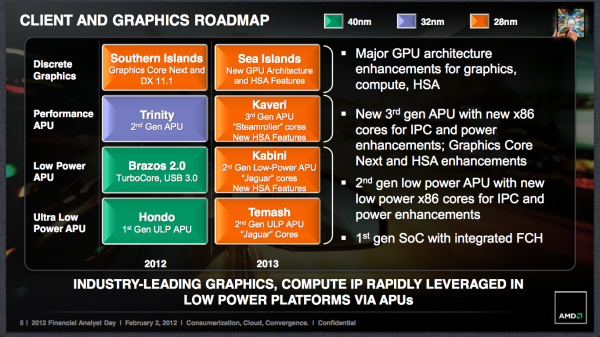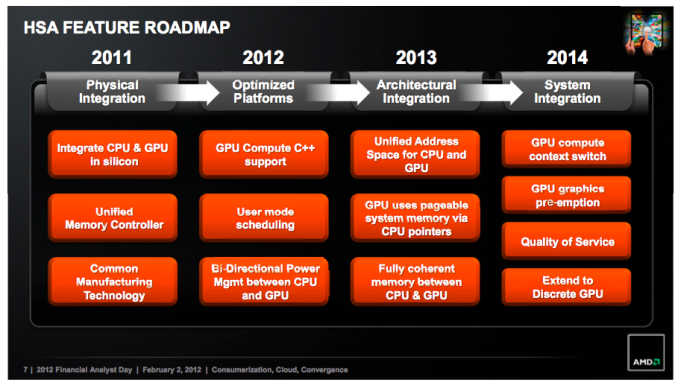AMD Radeon HD 7790 Review Feat. Sapphire: The First Desktop Sea Islands
by Ryan Smith on March 22, 2013 12:01 AM EST- Posted in
- GPUs
- AMD
- Sapphire
- GCN
- Radeon HD 7000
Bonaire’s Microarchitecture - What We’re Calling GCN 1.1
With our introduction out of the way, before looking at the cards and our performance results we would like to dive into a technical discussion and a bit of nitpicking. Specifically we would like to spend some time talking about architectures and product naming, as it’s going to be a bit confusing at first. As AMD has stated numerous times in the past, Graphics Core Next is a long-term architecture for the company. AMD intends to evolve GCN over the years, releasing multiple microarchitectures based on GCN that improve the architecture and add features while still being rooted in the design principles of GCN. GCN is after all the other half of AMD’s upcoming HSA-capable APUs, the culmination of years of AMD’s efforts with HSA/Fusion.
So where does Bonaire fit in? Bonaire is of course a GCN part; it’s a new microarchitecture that’s technically different from Southern Islands, but on the whole it’s a microarchitecture that’s extremely close in design to Southern Islands. In this new microarchitecture there are some changes – among other things the new microarchitecture implements some new instructions that will be useful for HSA, support for a larger number of compute work queues (also good for HSA) and it also implements a new version of AMD’s PowerTune technology (which we’ll get to in a bit) – but otherwise the differences from Southern Islands are very few. There are no notable changes in shader/CU efficiency, ROP efficiency, graphics features, etc. Unless you’re writing compute code for AMD GPUs, from what we know about this microarchitecture it’s likely you’d never notice a difference.
Unfortunately AMD has chosen to more-or-less gloss over the microarchitectural differences altogether, which is not wholly surprising since they will be selling Bonaire and previous generation products side-by-side. Bonaire’s microarchitecture has no official name (at least not one AMD wants to give us) and no version number. The Sea Islands name we’ve been seeing thrown around is not the microarchitecture name. Sea Islands is in fact the name for all of the GPUs in this wave – or perhaps it would be better to say all of the products created in this development cycle – including both Bonaire and it’s new microarchitecture, and Oland, AMD’s other new GPU primarily for mobile that is purely Southern Islands in microarchitecture.

In fact if not for the fact that AMD released (and then retracted) an ISA document called “AMD Sea Islands Instruction Set Architecture” last month, we would likely know even less about Bonaire’s microarchitecture. The document has been retracted at least in part due to the name (since AMD will not be calling the microarchitecture Sea Islands after all), so as a whole AMD isn’t particularly keen in talking about their microarchitecture at this time. But at the same time from a product standpoint it gives you an idea of how AMD is intending to smoothly offer both Southern Islands and Bonaire microarchitecture parts together as one product family.
Anyhow, for the sake of our sanity and for our discussions, in lieu of an official name from AMD we’re going to be retroactively renaming AMD’s GCN microarchitectures in order to quickly tell them apart. For the rest of this article and in future articles we will be referring to Southern Islands as GCN 1.0, while Bonaire’s microarchitecture will be GCN 1.1, to reflect the small changes between it and the first rendition of GCN.
Ultimately the differences between GCN 1.0 and GCN 1.1 are extremely minor, but they are real. But despite our general annoyance in how this has been handled, for consumers the difference between a GCN 1.0 card like the 7770 and a GCN 1.1 card like the 7790 should be limited to their innate performance differences, and of course PowerTune. GCN 1.1 or not, Bonaire fits in nicely in AMD’s current product stack and is in a position where it’s reasonable for it to be lumped together with GCN 1.0 parts as a single family. It’s really only the technical enthusiasts (like ourselves) and programmers that should have any significant reason to care about GCN 1.0 versus GCN 1.1. For everyone else this may just as well be another Southern Islands part.











107 Comments
View All Comments
silverblue - Friday, March 22, 2013 - link
Not at 176GB/s, unless they're clocking that GDDR5 VERY high. The 7790 is good for 96GB/s.Shut up and drink - Friday, March 22, 2013 - link
Sony's previous two consoles (PS2 and PS3)have traditionally favored high frequency/bandwidth proprietary Interconnects between components (see Cell's EIB) so this is likely where the "secret sauce" Sony R&D came in, thus facilitating the 176GB/S.AMD was quoted (can't find link) that said Sony engineering would be excluded if/when they release a PC variant of said APU.
Spunjji - Friday, March 22, 2013 - link
Very, very interesting indeed. It tallies well with the numbers. There was me thinking they had bolted Pitcairn onto the side of their CPUs but this combo might make more sense (and yet also less sense).lopri - Friday, March 22, 2013 - link
Totally agree with memory size. At this performance and price level, 2 GB should be default.lopri - Friday, March 22, 2013 - link
Then again, it would be strange if AMD doesn't release "larger" cards based on this updated GCN core.silverblue - Friday, March 22, 2013 - link
Perhaps the reason for the lack of a 2GB version would be that it would be too close to the 7850...?CeriseCogburn - Sunday, March 24, 2013 - link
NO it SLOWS THE CARD DOWN with it's crappy amd core...Haven't you been paying attention for like the YEARS you've been here ?
My apologies if you're an epileptic.
Tams80 - Monday, April 1, 2013 - link
I don't understand why you haven't been banned yet. You add nothing to the discussion with your posts other than vitriol. Please either be civil and logical, or go away.CeriseCogburn - Sunday, March 24, 2013 - link
AMD always releases 1GB models and 2GB models so the amd fanboys can quote the 1GB model cheapo powercolor low end price, claim it wins price perf, then go on raging about how the 2GB model covers the high end ...ROFL - That's what they do - they even do it when comparing to a 2GB nVidia, suddenly forgetting amd makes crapster 1GB they swore off years ago, even though that's the screamer amd fanboy price "they pay" because "it's such a deal! Man! "
Brainfart Bart they should be called.
R3MF - Monday, March 25, 2013 - link
Actually, they didn't with the 7770.Your constant whining is about as welcome as a bout of herpes, scram.